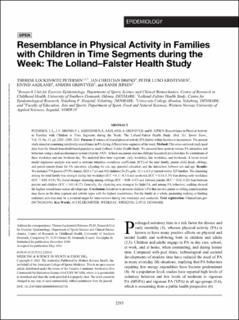| dc.contributor.author | Petersen, Therese Lockenwitz | |
| dc.contributor.author | Brønd, Jan Christian | |
| dc.contributor.author | Kristensen, Peter Lund | |
| dc.contributor.author | Aadland, Eivind | |
| dc.contributor.author | Grøntved, Anders | |
| dc.contributor.author | Jepsen, Randi | |
| dc.date.accessioned | 2022-02-16T10:03:01Z | |
| dc.date.available | 2022-02-16T10:03:01Z | |
| dc.date.created | 2021-11-23T14:29:52Z | |
| dc.date.issued | 2021 | |
| dc.identifier.citation | Petersen, T. L., Brønd, J. C., Kristensen, P. L., Aadland, E., Grøntved, A., & Jepsen, R. (2021). Resemblance in Physical Activity in Families with Children in Time Segments during the Week: The Lolland–Falster Health Study. Medicine & Science in Sports & Exercise, 53(11), 2283-2289. | en_US |
| dc.identifier.issn | 0195-9131 | |
| dc.identifier.uri | https://hdl.handle.net/11250/2979300 | |
| dc.description.abstract | Purpose
Evidence of shared physical activity (PA) habits within families is inconsistent. The present study aimed at examining intrafamily resemblance in PA during different time segments of the week.
Method
This cross-sectional study used data from the Danish household-based population study Lolland–Falster Health Study. We assessed time spent in various PA intensities and behaviors using a dual-accelerometer system (Axivity AX3). At least one parent and one child per household provided data for a minimum of three weekdays and one weekend day. We analyzed three time segments: early weekdays, late weekdays, and weekends. A linear mixed model regression analysis was used to estimate intraclass correlation coefficients (ICC) of the total family, parent–child dyads, siblings, and parent–parent dyads for PA outcomes, adjusting for sex, age, parental education, and the interaction between sex and age.
Results
We included 774 parents (57.9% female, 42.8 ± 7 yr) and 802 children (54.2% girls, 11.1 ± 4.3 yr) nested within 523 families. The clustering among the total family was stronger during late weekdays (ICC = 0.11–0.31) and weekends (ICC = 0.14–0.29) than during early weekdays (ICC = 0.02–0.19). We found stronger clustering among siblings (ICC = 0.08–0.47) and between parents (ICC = 0.02–0.52) than between parents and children (ICC < 0.01–0.37). Generally, the clustering was strongest for light PA, and among PA behaviors, walking showed the highest resemblance across all subgroups.
Conclusion
Initiatives to promote children’s PA that involve parent or sibling coparticipation may focus on the time segment and activity types with the highest resemblance. For the family as a whole, promoting walking or limiting sedentary activities may be a potential target for interventions during late weekdays and weekends.
Trial registration: Clinicaltrials.gov (NCT02482896). | en_US |
| dc.language.iso | eng | en_US |
| dc.publisher | Wolters Kluwer Health, Inc | en_US |
| dc.rights | Attribution-NonCommercial-NoDerivatives 4.0 Internasjonal | * |
| dc.rights.uri | http://creativecommons.org/licenses/by-nc-nd/4.0/deed.no | * |
| dc.title | Resemblance in Physical Activity in Families with Children in Time Segments during the Week: The Lolland-Falster Health Study | en_US |
| dc.type | Peer reviewed | en_US |
| dc.type | Journal article | en_US |
| dc.description.version | publishedVersion | en_US |
| dc.rights.holder | © 2021 The Author(s). | en_US |
| dc.source.pagenumber | 2283-2289 | en_US |
| dc.source.volume | 53 | en_US |
| dc.source.journal | Medicine & Science in Sports & Exercise | en_US |
| dc.source.issue | 11 | en_US |
| dc.identifier.doi | 10.1249/MSS.0000000000002718 | |
| dc.identifier.cristin | 1957884 | |
| cristin.ispublished | true | |
| cristin.fulltext | original | |
| cristin.qualitycode | 2 | |

